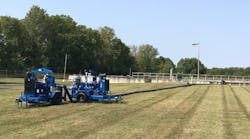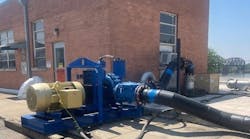Howell, Mich., is about 50 miles northwest of Detroit along the I-96 corridor, an area that has faced significant residential construction in the past 10 years. In 2006, the growth started to become a problem in terms of serving the wastewater needs in the area, until Severn Trent Services was called upon to help.
Growth and expansion
In the mid 1990s, Howell and the neighboring townships of Marion, Oceola and Genoa together formed (using the first letters of the township names) the MHOG Sewer and Water Authority to provide water services to the four townships. Serving the water needs of the area – each town incorporates approximately 36 square miles – required a system that had more than 140 miles of pipeline ranging 8 to 20 in. in diameter. The Authority utilized four pressure districts and five elevated water towers holding 6.3 million gallons of water. The complex system requires the movement of large quantities of water over long distances to serve customers, and it is computer controlled and monitored by the operators of the water treatment plant. The system also interconnects with the cities of Howell and Brighton for use in emergencies.
In 1996, with growth on the outskirts of Detroit projected to overtake the capacity of its infrastructure, the Authority began construction of a 2 mgd groundwater lime softening and iron removal plant in the far western section of the service area. By reducing calcium carbonate hardness from 250mg/l to 100mg/l and iron from ? part per million to zero parts per million, the plant would improve the taste of the water and reduce the possibility of stained plumbing fixtures.
The plant is located right above the Marshall Sandstone aquifer, a large source of water capable of meeting the service area’s needs. The MHOG plant, which was constructed to be easily retrofitted to a 4 mgd plant if required, went on line in January 1998, and it was anticipated that expansion to full capacity would be required in five years. However, with residential construction booming and commercial enterprises flourishing in and around the four townships, it became necessary to expand the plant to 4 mgd in 2001. Construction costs were approximately $6 million.
By 2003, the plant was operating at more than 75 percent of capacity during peak usage days. With area growth continuing unabated, the Authority approved the development of plans for an 8 mgd addition to the existing plant. This was to be a stand-alone plant with connections to the original facility that would provide the flexibility to operate at a capacity of 4, 8 or 12 mgd, or up to 16 mgd when using blended water from other system sources. The new plant was to be constructed on a large tract of land adjacent to the existing plant and would incorporate the use of six existing wells, each of which was capable of producing 2 mgd. Construction of the new plant began in the summer of 2004 with planned construction costs of approximately $11 million.
In February 2006, as the plant was nearing completion, the Authority, which had been outsourcing operation and maintenance of the MHOG plant, hired Severn Trent Services as the new operator. The company brought 15 professionals to the job, including two with F1 licenses, maintenance experts who are certified in water treatment and distribution. It became the staff’s responsibility to work with the engineers, builders and regulatory agencies to get the new plant operating and online before the high usage of the summer of 2006. With only four months to make the transition, the staff completed the punch lists, developed standard operating procedures for the plant, implemented process control procedures and completed staff training for the new facility.
“The Severn Trent staff had to come up to speed quickly,” said Greg Tatara, utilities director for the MHOG Authority. “I was impressed with their ability to make sure the plant’s procedures were in place in such a short time frame. With this area’s fast-growing population, the flexibility and responsiveness of the Authority and our partners is critical. From operating procedures to staff training and licensing, the entire start-up process went smoothly.”
Eric Risch is the Marketing Manager of Severn Trent Services. He can be reached at 215-997-4058, or by email at [email protected].


